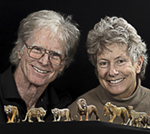
Before
Alaska Brown Bear Photo Tours – August 2019
Trip Reports
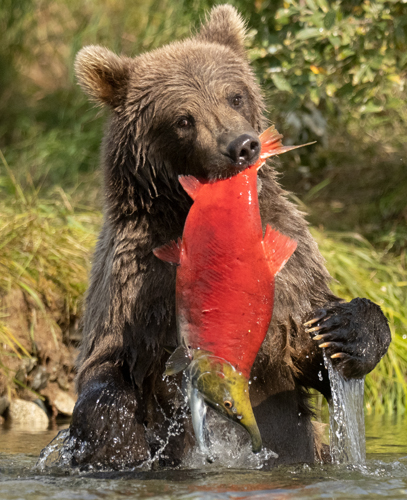
After
Coastal Katmai’s Brown Bears
We’ve been traveling to coastal Alaska for Brown Bears for over twenty years, and we’ve never been disappointed. This trip was no exception!
Our base was the Coastal Explorer, our friend Chuck Keim’s boat, where we slept, ate (too much), and from which we did skiff rides to shore each day to photograph the bears as they fished for salmon. This year was a record-setter, the driest and perhaps the hottest summer on record. Anchorage was in a major drought, as was most of southern Alaska. When we arrived at Geographic Harbor, our shooting site, we immediately noticed that the river’s flow was much reduced, but fortunately, salmon were still swimming upstream to spawn.
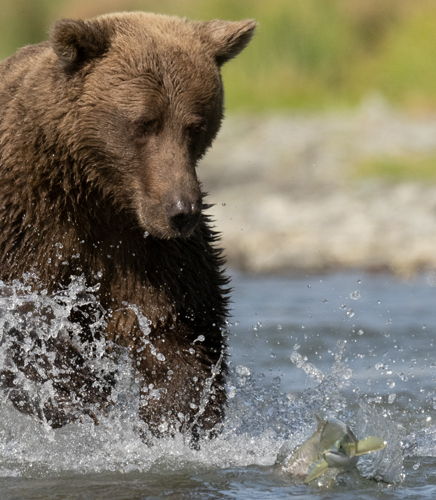
I anticipated a vertical, but as fast as the action occurs as a Brown
Bear charged towards the camera, chasing a salmon. Most times, the
salmon stays hidden, but this one leaped free of the water to attempt
to escape. I use Continuous Low, which follows action incredibly well.
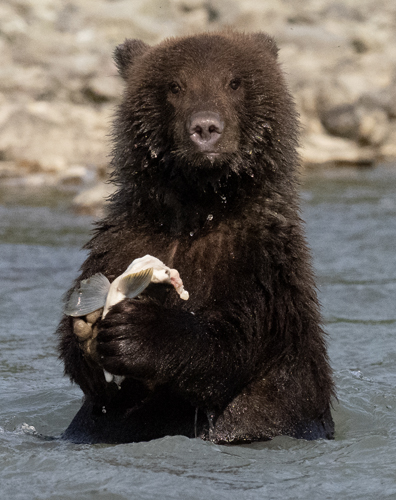
We had a very tolerant mother bear with a lone cub, and the
cub performed, mimicking Mom in trying to catch fish, and
playing with any fish, alive or dead, it found.
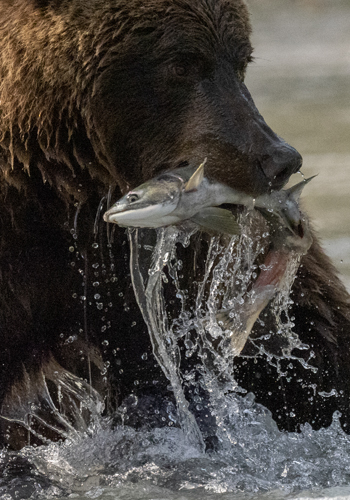 Over the next four days we photographed the Brown Bears as they fished, wrestled, or chased one another. Our day began with a hike across the tide flats, revealed as an immense plain at low tide. On some mornings the tidal flats were almost empty, but by the time we walked to the viewing area bears usually appeared. By the time we settled in, we could count on at least one bear working its way upstream, and soon followed by several others. Although I used the equivalent of 840mm (300mm w 1.4X on the M1X), often the best lense was in the 100-400mm range, especially for catching a salmon in view as a bear charged across the shallows in pursuit. On a couple occasions I tried using my Olympus Tough 6 to do video of salmon swimming upstream, but despite the shallow water the turbidity was too much. I hoped to try again at our next destination.
Over the next four days we photographed the Brown Bears as they fished, wrestled, or chased one another. Our day began with a hike across the tide flats, revealed as an immense plain at low tide. On some mornings the tidal flats were almost empty, but by the time we walked to the viewing area bears usually appeared. By the time we settled in, we could count on at least one bear working its way upstream, and soon followed by several others. Although I used the equivalent of 840mm (300mm w 1.4X on the M1X), often the best lense was in the 100-400mm range, especially for catching a salmon in view as a bear charged across the shallows in pursuit. On a couple occasions I tried using my Olympus Tough 6 to do video of salmon swimming upstream, but despite the shallow water the turbidity was too much. I hoped to try again at our next destination.
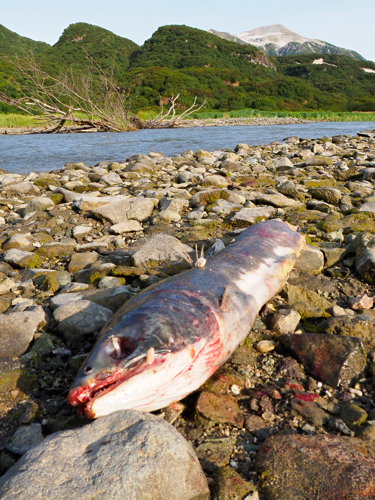 We had one day of rain, which didn’t deter some of our participants from going ashore and photographing, but otherwise the weather was spectacular. In a normal year, we expect having at least a few days of rain in a two week period, which challenges shutter speeds but otherwise provides for nice, even light. This year, with the near continuous sunlight, fast shutter speeds and capturing action was the rule!
We had one day of rain, which didn’t deter some of our participants from going ashore and photographing, but otherwise the weather was spectacular. In a normal year, we expect having at least a few days of rain in a two week period, which challenges shutter speeds but otherwise provides for nice, even light. This year, with the near continuous sunlight, fast shutter speeds and capturing action was the rule!
Our visit coincided with the high tide that usually appear during mid-day, so after a long morning shoot we took the time, twice, to explore new photo opportunities. Taking the skiff, we photographed Bald Eagles, Harelequin Ducks and Marbled Murrelets. A large haulout of Harbor Seals were extremely cooperative, as was one Sea Otter who floated on his back, oblivous to our skiff.
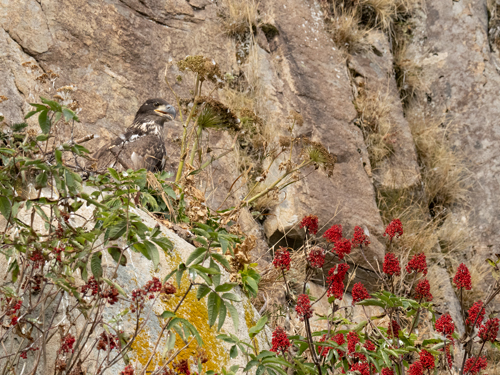
Immature Bald Eagle - we had to look closely!
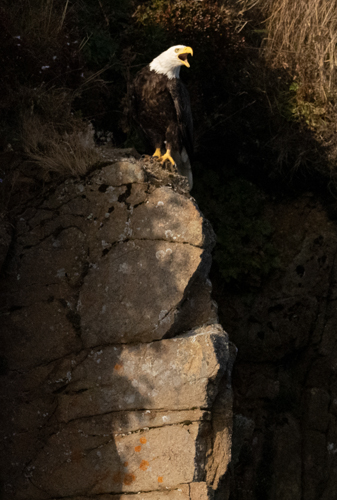
One of the joys of mirrorless is seeing EXACTLY what the exposure will be,
in real time, as we're shooting. So a potentially contrasty scene, like this
Bald Eagle, is no problem, and doesn't require the annoying, time-wasting,
and potentially shot-losing habit of 'chimping.'
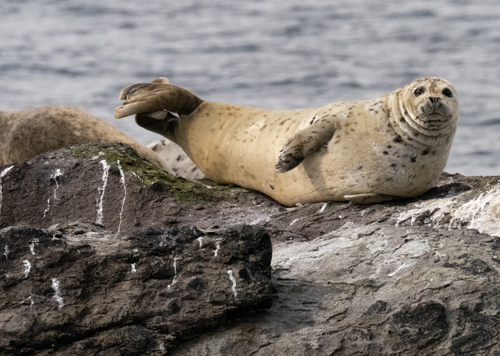
Image stabilization with the Olympus M1X and Mark II, even at 840mm, is
incredible, and I was hand-holding the lens, resting the lens foot on my left hand,
that rested on the railing of our boat.
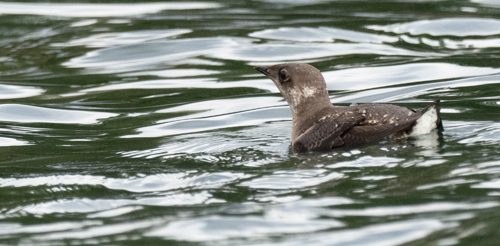
In the past, I never would have attempted carrying or trying to use 800mm
on a skiff, since hand-holding a heavy lens would have been impossible in
a less-than-stable environment. With the small size of my 840mm (300mm
and 1.4X teleconverter) I not only could hand-hold, I could also move about
freely and easily. That's an advantage photographers don't consider, but
one that is extremely important. That's how I got this Marbled Murrelet.
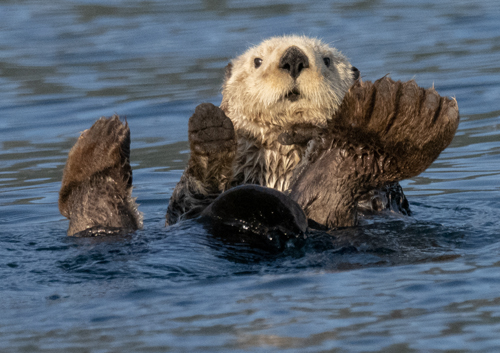
The Sea Otter has the densest fur coat of any mammal, insulating it from the
cold Alaskan waters. That's one of its enormous hind feet that's waving at the camera.
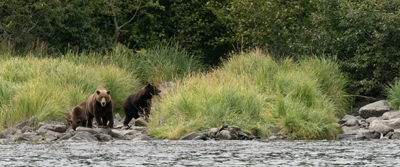
During one high tide we sailed to a bay further north where we hoped to find more bears. Oddly enough, although we saw a few bears the shooting, for bears, wasn’t rewarding, but in the shallows of one of the river’s mouth, thousands of Silver Salmon were gathered, waiting to swim upriver to swan. Seeing schools of salmon swarming below our skiff I regretted not carrying my Olympus Tough 6, which functions well as an underwater camera. Although that opportunity was lost, we did have a great shooting opportunity, as salmon often jumped, clearing the water either to catch insects or to demonstrate fitness. These breaching salmon were challenging, as fish jumped from unpredictable locations, but some would jump repeatedly, giving us a change to roughly focus on that area and be ready for the next shoot.
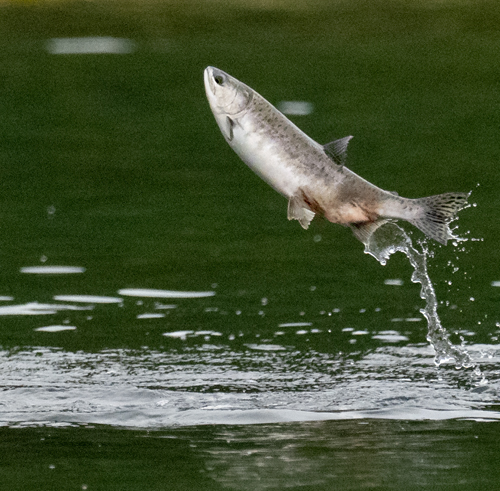
1/2000th, above, 1/4000th below, with ProCapture.
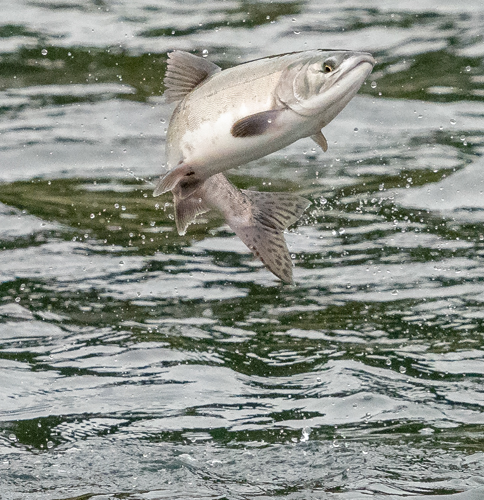
Although one of our participants caught a great shot in the traditional way,
as I have in the past, using ProCapture it was so easy, and I captured
scores of shots. The challenge was picking the one that best illustrated
the leap of the salmon.
Mary and I were using ProCapture, where we recorded 35 frames prior to our pressing the shutter and actually snapping a shot. In this way, when a salmon leaped and we fired, although the fish was usually on its way back into the water, we caught the entire sequence as a fish emerged from an otherwise featureless stretch of water. For us, those captures were incredibly easy, but I must commend Jon who used his Canon gear and caught at least one exceptional shot using ’traditional’ shooting methods.
Returning to Geographic Harbor that afternoon, it began to rain, which continued through the next day. That was our second to last, and we were happy to see the skies cleared overnight, giving us great weather for our last shoot.
As usual, the food was spectacular and we all ate too much, but we could rationalize our diet by all the work our index fingers were doing, snapping down on the shutter button!
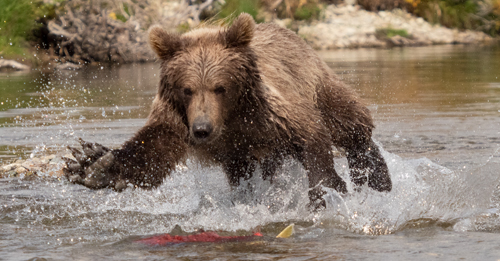
Alaska 2019 Jacque’s Grizzly Camp
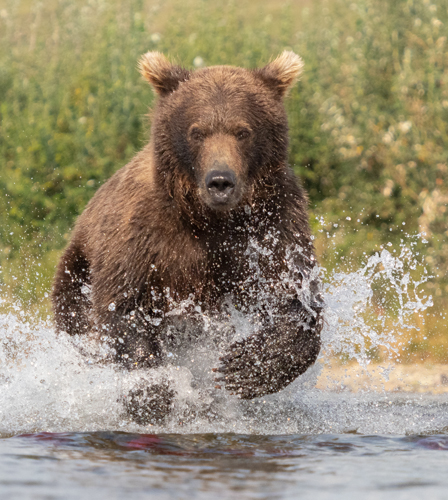 This was our first photo tour to this Katmai National Park camp and lodge, which caters to Photographers and fishermen. Last year, during another Alaska Photo Tour, Mary had toured the camp and, via a sight-seeing flight, flew over several of the shooting locations we might visit. She was impressed, and based on the stellar credentials of some of the other professional photographers that use the camp, we were confident the experience would be outstanding.
This was our first photo tour to this Katmai National Park camp and lodge, which caters to Photographers and fishermen. Last year, during another Alaska Photo Tour, Mary had toured the camp and, via a sight-seeing flight, flew over several of the shooting locations we might visit. She was impressed, and based on the stellar credentials of some of the other professional photographers that use the camp, we were confident the experience would be outstanding.
And it was.
Flying from one photo location to another via floatplanes – small airplanes with large pontoons replacing the usual wheels – provides a perspective of the absolute immensity of Alaska. The camp was based on the shores of Lake Illiama, an inland sea of fresh water measuring 78 miles long and 15 miles wide, big enough that even from the air distant horizons were beyond the curvature of the earth. Lake K, at Brooks Falls, is equally large, giving the impression that we were flying along the Alaska coast.
At one point, I commented to my pilot that I expected to see seals hauled out on some of the rocky islands dotting the lake. I was surprised when he responded, informing me that indeed there was a population of Harbor Seals in the lake, a subspecies of this normally marine species. Only one other seal, to my knowledge, inhabits fresh water, the Lake Baikal Seal that is found in Russia. To my delight, we deviated somewhat in our flight, flying over the crescent-shaped sand spit where seals regularly haul out, and a few dozen were stretched out on the sands below.
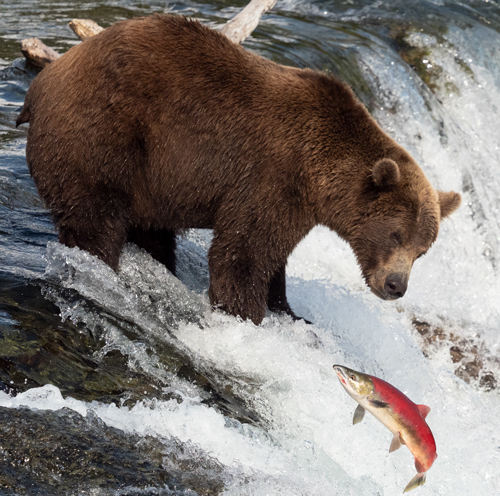
Although the bears at Brooks Falls has been shot seemingly forever,
everyone (including Mary and I) still want that iconic shot of the Brown Bears
at the falls. Because of the drought, the salmon run was reduced, but fish were
jumping often enough to keep us interested. With ProCapture, getting a shot of
a jumping Salmon was a breeze.
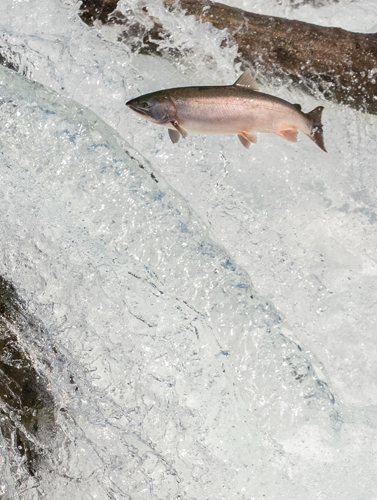
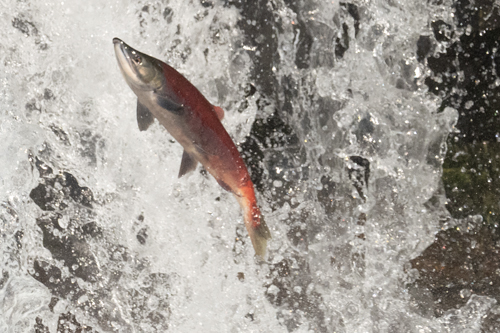
ProCapture at 1/4000th and 1/8000th second.
We were here for Brown Bears, of course, and we had plenty. We started our first shoot at Brooks Falls in Katmai National Park’s main tourist destination. I was not enthusiastic about visiting Brooks, as I’ve been there before at what must have been peak season, where the viewing platform was crowded and annoying. During peak season, photographers are usually not allowed to use tripods, and visitors are often limited to a one hour session before being rotated off the platform. I’m told that buzzers, like those used at crowded restaurants, are given to a group leader to alert them that their rotation was ready to start, and the consequent hour of viewing. I didn’t need that. We were told that the crowds were gone, now, and the viewing would be good, even though the bear activity would not be as frequent as during peak season. That proved true.
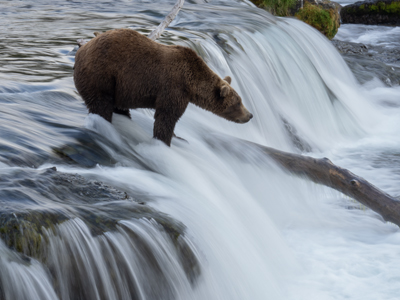 Our experience at Brooks was a good one. After doing the mandatory ‘Bear School’ where basic bear viewing protocol was covered, we headed to the Falls, a mile long walk. An elevated platform now spans the mouth of the Brooks River – an improvement over the extremely inefficient and annoying floating bridge of former years. Then, if a bear was sleeping or feeding near the bridge, Park Rangers stopped all traffic, sometimes causing waits of over an hour, and missed flights for some. Now, we safely passed over bear country, and the schools of red Sockeye Salmon that floated in the shallows.
Our experience at Brooks was a good one. After doing the mandatory ‘Bear School’ where basic bear viewing protocol was covered, we headed to the Falls, a mile long walk. An elevated platform now spans the mouth of the Brooks River – an improvement over the extremely inefficient and annoying floating bridge of former years. Then, if a bear was sleeping or feeding near the bridge, Park Rangers stopped all traffic, sometimes causing waits of over an hour, and missed flights for some. Now, we safely passed over bear country, and the schools of red Sockeye Salmon that floated in the shallows.
When we arrived at the viewing Platform there was enough room for everyone in our group, and as the morning progressed most of the tourists left. Mary, Scott, Judy, and I passed on hiking the mile back to the lodge for lunch – where we were required to store our lunches, and remained on the platform all day. In the afternoon, as the light switched to directly over our shoulders for contrast-free lighting, bears began to use the top of the falls for fishing – giving us that iconic view everyone sought. We did well.
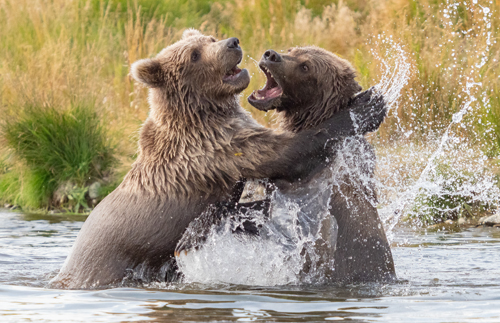
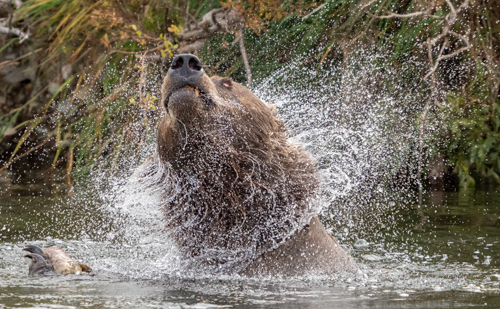
On subsequent days we flew to another destination in Katmai where we saw no other photographers, and on some visits, no fisherman either. At these spots we had water-level views of bears fishing, often charging in the very shallow water straight towards us, the red, humped back of a fleeing salmon sometimes appearing above the water as the salmon attempted an escape. Most didn’t succeed.
Over these three days we averaged over ten bears a session, including a mother Brown Bear with two cubs of the year – small cubs – that fished close by, and at one point slept on the bank while her cubs played, completely at ease with our presence. Another mother, with two two-year-old cubs, provided a real show, with the cubs grabbing and juggling fish, the bright red salmon flashing like neon against the dark, wet fur of the cubs. Cubs often wrestled, and using the flip-out screens of the Olympus M1X and Mark II, I often shot at ground-level, getting a true water level perspective.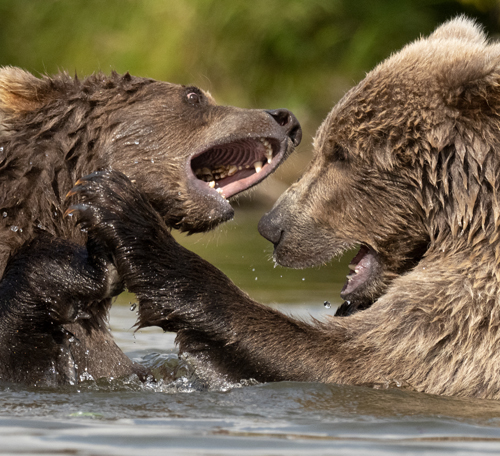
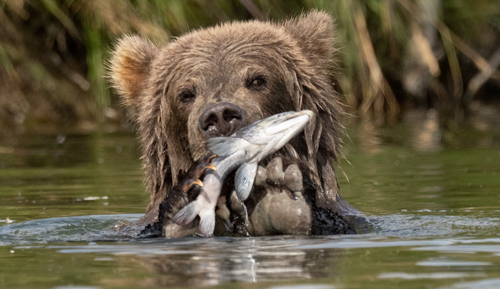
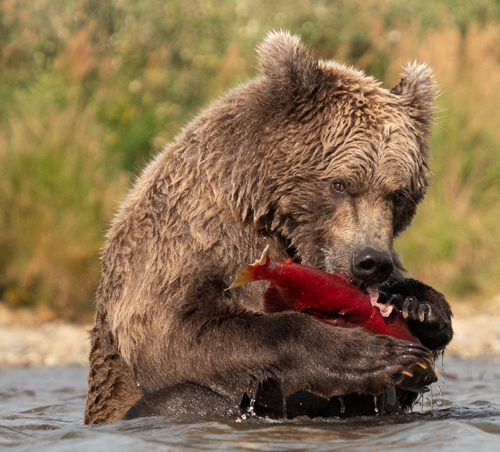
The water clarity at these inland locations was quite clear, and so Mary and I, and Judy, had a chance to do some underwater video of the Sockeye Salmon swimming upstream. Mary and I used our Olympus Tough 6 cameras, with our smal PointnShoots that do very well as an underwater camera. We used Toughs on our Humpback Whale shoot in February. These shots are excerpts from the video footage, processed in Photoshop. Not bad!.
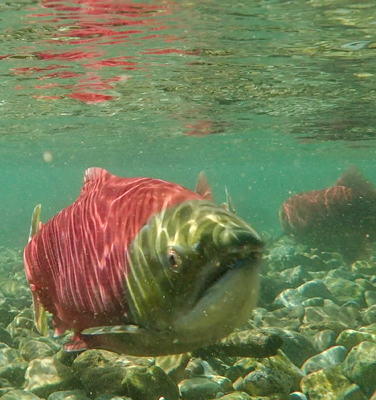
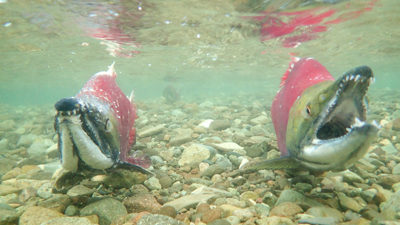

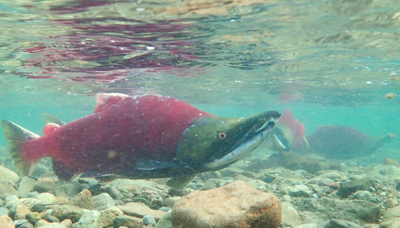
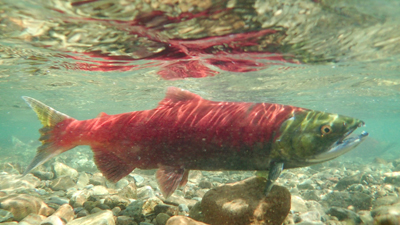
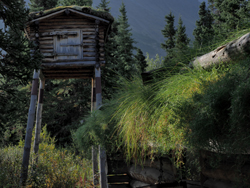 On our last day we only had the morning, as all of us were flying out in mid-afternoon to Anchorage and our flights home. Jerry suggested a visit to Lake Clark and Richard Louis Proenneke’s Cabin. I didn’t know anything about Proenneke, who lived along Lake Clark for 19 seasons after building a cabin from scratch. A book and a PBS special (One Man’s Wilderness) details his accomplishments.
On our last day we only had the morning, as all of us were flying out in mid-afternoon to Anchorage and our flights home. Jerry suggested a visit to Lake Clark and Richard Louis Proenneke’s Cabin. I didn’t know anything about Proenneke, who lived along Lake Clark for 19 seasons after building a cabin from scratch. A book and a PBS special (One Man’s Wilderness) details his accomplishments.
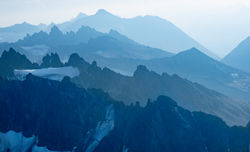
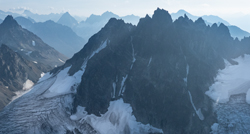
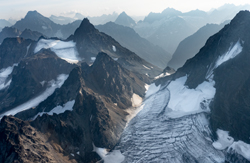
At any rate, the flight to the Lake and his cabin – now a hand’s on exhibit at Lake Clark National Park – was spectacular, taking us over and through the most rugged mountains I’ve ever seen. Truly saw-toothed, jagged, steep, carved by glaciers and a bit frightening in the sense that any engine failure in our small plane would have been … interesting. We landed on the glacial fed lake, coasted to shore, and were met by a Park Ranger, a pleasant young lady who would spend her summer here, basically alone, unless she paid for her own flight for a short vacation outside her isolated valley. I wondered why in the world the Park Service wouldn’t pay for a couple of flights for their rangers – it is a lonely life. The cabin and how this man from New England forged a home was very interesting, and gave me a chance to do some Focus Stacking and HDRs in camera, techniques I didn’t have a chance to do when photographing the bears.
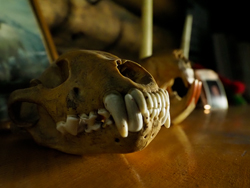
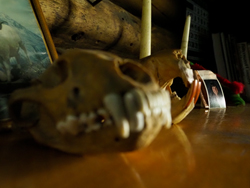
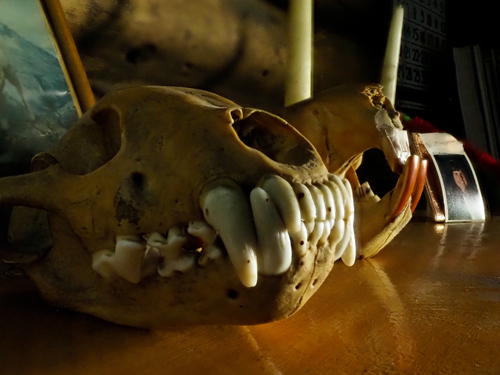
Here's a Wolverine and a Beaver skull, and a Photograph, from inside
the cabin. I used In-Camera Focus Stacking, hand-holding, but bracing the
front of the lens on the bookshelf. The 12-100mm was only about 3 inches
from the front skull and was shot at 1/25sec at f4.5. That's the depth of field
that resulted from the stacking!
lmpressive!
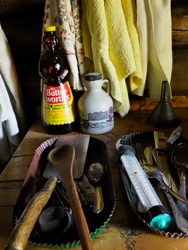
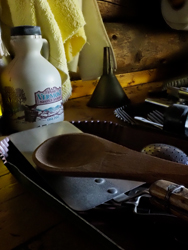
Two more examples of focus stacking in-camera, at1/25th sec, f4.5, hand-held.
With that, our tours to Alaska drew to a close, with 10 days or so in the field, and one day of rain. We photographed Bald Eagles, Sea Otters, Brown Bears, Gyrfalcons, Ptarmigan, and several sea birds in our two weeks, with some of the best bear photography we’ve had in years. We’ll be returning to both locations in 2021. Join Us!
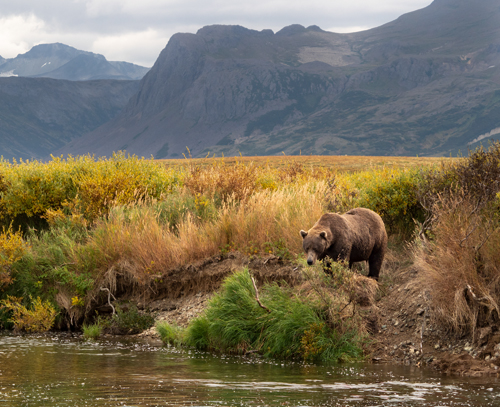
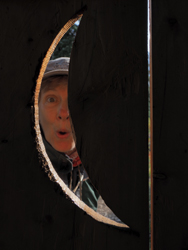
Why you should travel with us
Testimonials
Check out the prices -
Olympus Official Store
Featured on ShotKit - read the interview
Join us on Facebook at: Follow Hoot Hollow
Office Phone: (717) 543-6423
Or FAX us at: (717) 543-5342
Mary and Joe are proud to endorse the Photo Retailer that has
done the absolute most in supporting nature photography in all
its facets ---

Check out the Monthly Specials
from Hunt's

Before
Alaska Brown Bear Photo Tours – August 2019
Trip Reports

After
Coastal Katmai’s Brown Bears
We’ve been traveling to coastal Alaska for Brown Bears for over twenty years, and we’ve never been disappointed. This trip was no exception!
Our base was the Coastal Explorer, our friend Chuck Keim’s boat, where we slept, ate (too much), and from which we did skiff rides to shore each day to photograph the bears as they fished for salmon. This year was a record-setter, the driest and perhaps the hottest summer on record. Anchorage was in a major drought, as was most of southern Alaska. When we arrived at Geographic Harbor, our shooting site, we immediately noticed that the river’s flow was much reduced, but fortunately, salmon were still swimming upstream to spawn.

I anticipated a vertical, but as fast as the action occurs as a Brown
Bear charged towards the camera, chasing a salmon. Most times, the
salmon stays hidden, but this one leaped free of the water to attempt
to escape. I use Continuous Low, which follows action incredibly well.

We had a very tolerant mother bear with a lone cub, and the
cub performed, mimicking Mom in trying to catch fish, and
playing with any fish, alive or dead, it found.
 Over the next four days we photographed the Brown Bears as they fished, wrestled, or chased one another. Our day began with a hike across the tide flats, revealed as an immense plain at low tide. On some mornings the tidal flats were almost empty, but by the time we walked to the viewing area bears usually appeared. By the time we settled in, we could count on at least one bear working its way upstream, and soon followed by several others. Although I used the equivalent of 840mm (300mm w 1.4X on the M1X), often the best lense was in the 100-400mm range, especially for catching a salmon in view as a bear charged across the shallows in pursuit. On a couple occasions I tried using my Olympus Tough 6 to do video of salmon swimming upstream, but despite the shallow water the turbidity was too much. I hoped to try again at our next destination.
Over the next four days we photographed the Brown Bears as they fished, wrestled, or chased one another. Our day began with a hike across the tide flats, revealed as an immense plain at low tide. On some mornings the tidal flats were almost empty, but by the time we walked to the viewing area bears usually appeared. By the time we settled in, we could count on at least one bear working its way upstream, and soon followed by several others. Although I used the equivalent of 840mm (300mm w 1.4X on the M1X), often the best lense was in the 100-400mm range, especially for catching a salmon in view as a bear charged across the shallows in pursuit. On a couple occasions I tried using my Olympus Tough 6 to do video of salmon swimming upstream, but despite the shallow water the turbidity was too much. I hoped to try again at our next destination.
 We had one day of rain, which didn’t deter some of our participants from going ashore and photographing, but otherwise the weather was spectacular. In a normal year, we expect having at least a few days of rain in a two week period, which challenges shutter speeds but otherwise provides for nice, even light. This year, with the near continuous sunlight, fast shutter speeds and capturing action was the rule!
We had one day of rain, which didn’t deter some of our participants from going ashore and photographing, but otherwise the weather was spectacular. In a normal year, we expect having at least a few days of rain in a two week period, which challenges shutter speeds but otherwise provides for nice, even light. This year, with the near continuous sunlight, fast shutter speeds and capturing action was the rule!
Our visit coincided with the high tide that usually appear during mid-day, so after a long morning shoot we took the time, twice, to explore new photo opportunities. Taking the skiff, we photographed Bald Eagles, Harelequin Ducks and Marbled Murrelets. A large haulout of Harbor Seals were extremely cooperative, as was one Sea Otter who floated on his back, oblivous to our skiff.

Immature Bald Eagle - we had to look closely!

One of the joys of mirrorless is seeing EXACTLY what the exposure will be,
in real time, as we're shooting. So a potentially contrasty scene, like this
Bald Eagle, is no problem, and doesn't require the annoying, time-wasting,
and potentially shot-losing habit of 'chimping.'

Image stabilization with the Olympus M1X and Mark II, even at 840mm, is
incredible, and I was hand-holding the lens, resting the lens foot on my left hand,
that rested on the railing of our boat.

In the past, I never would have attempted carrying or trying to use 800mm
on a skiff, since hand-holding a heavy lens would have been impossible in
a less-than-stable environment. With the small size of my 840mm (300mm
and 1.4X teleconverter) I not only could hand-hold, I could also move about
freely and easily. That's an advantage photographers don't consider, but
one that is extremely important. That's how I got this Marbled Murrelet.

The Sea Otter has the densest fur coat of any mammal, insulating it from the
cold Alaskan waters. That's one of its enormous hind feet that's waving at the camera.

During one high tide we sailed to a bay further north where we hoped to find more bears. Oddly enough, although we saw a few bears the shooting, for bears, wasn’t rewarding, but in the shallows of one of the river’s mouth, thousands of Silver Salmon were gathered, waiting to swim upriver to swan. Seeing schools of salmon swarming below our skiff I regretted not carrying my Olympus Tough 6, which functions well as an underwater camera. Although that opportunity was lost, we did have a great shooting opportunity, as salmon often jumped, clearing the water either to catch insects or to demonstrate fitness. These breaching salmon were challenging, as fish jumped from unpredictable locations, but some would jump repeatedly, giving us a change to roughly focus on that area and be ready for the next shoot.

1/2000th, above, 1/4000th below, with ProCapture.

Although one of our participants caught a great shot in the traditional way,
as I have in the past, using ProCapture it was so easy, and I captured
scores of shots. The challenge was picking the one that best illustrated
the leap of the salmon.
Mary and I were using ProCapture, where we recorded 35 frames prior to our pressing the shutter and actually snapping a shot. In this way, when a salmon leaped and we fired, although the fish was usually on its way back into the water, we caught the entire sequence as a fish emerged from an otherwise featureless stretch of water. For us, those captures were incredibly easy, but I must commend Jon who used his Canon gear and caught at least one exceptional shot using ’traditional’ shooting methods.
Returning to Geographic Harbor that afternoon, it began to rain, which continued through the next day. That was our second to last, and we were happy to see the skies cleared overnight, giving us great weather for our last shoot.
As usual, the food was spectacular and we all ate too much, but we could rationalize our diet by all the work our index fingers were doing, snapping down on the shutter button!

Alaska 2019 Jacque’s Grizzly Camp
 This was our first photo tour to this Katmai National Park camp and lodge, which caters to Photographers and fishermen. Last year, during another Alaska Photo Tour, Mary had toured the camp and, via a sight-seeing flight, flew over several of the shooting locations we might visit. She was impressed, and based on the stellar credentials of some of the other professional photographers that use the camp, we were confident the experience would be outstanding.
This was our first photo tour to this Katmai National Park camp and lodge, which caters to Photographers and fishermen. Last year, during another Alaska Photo Tour, Mary had toured the camp and, via a sight-seeing flight, flew over several of the shooting locations we might visit. She was impressed, and based on the stellar credentials of some of the other professional photographers that use the camp, we were confident the experience would be outstanding.
And it was.
Flying from one photo location to another via floatplanes – small airplanes with large pontoons replacing the usual wheels – provides a perspective of the absolute immensity of Alaska. The camp was based on the shores of Lake Illiama, an inland sea of fresh water measuring 78 miles long and 15 miles wide, big enough that even from the air distant horizons were beyond the curvature of the earth. Lake K, at Brooks Falls, is equally large, giving the impression that we were flying along the Alaska coast.
At one point, I commented to my pilot that I expected to see seals hauled out on some of the rocky islands dotting the lake. I was surprised when he responded, informing me that indeed there was a population of Harbor Seals in the lake, a subspecies of this normally marine species. Only one other seal, to my knowledge, inhabits fresh water, the Lake Baikal Seal that is found in Russia. To my delight, we deviated somewhat in our flight, flying over the crescent-shaped sand spit where seals regularly haul out, and a few dozen were stretched out on the sands below.

Although the bears at Brooks Falls has been shot seemingly forever,
everyone (including Mary and I) still want that iconic shot of the Brown Bears
at the falls. Because of the drought, the salmon run was reduced, but fish were
jumping often enough to keep us interested. With ProCapture, getting a shot of
a jumping Salmon was a breeze.


ProCapture at 1/4000th and 1/8000th second.
We were here for Brown Bears, of course, and we had plenty. We started our first shoot at Brooks Falls in Katmai National Park’s main tourist destination. I was not enthusiastic about visiting Brooks, as I’ve been there before at what must have been peak season, where the viewing platform was crowded and annoying. During peak season, photographers are usually not allowed to use tripods, and visitors are often limited to a one hour session before being rotated off the platform. I’m told that buzzers, like those used at crowded restaurants, are given to a group leader to alert them that their rotation was ready to start, and the consequent hour of viewing. I didn’t need that. We were told that the crowds were gone, now, and the viewing would be good, even though the bear activity would not be as frequent as during peak season. That proved true.
 Our experience at Brooks was a good one. After doing the mandatory ‘Bear School’ where basic bear viewing protocol was covered, we headed to the Falls, a mile long walk. An elevated platform now spans the mouth of the Brooks River – an improvement over the extremely inefficient and annoying floating bridge of former years. Then, if a bear was sleeping or feeding near the bridge, Park Rangers stopped all traffic, sometimes causing waits of over an hour, and missed flights for some. Now, we safely passed over bear country, and the schools of red Sockeye Salmon that floated in the shallows.
Our experience at Brooks was a good one. After doing the mandatory ‘Bear School’ where basic bear viewing protocol was covered, we headed to the Falls, a mile long walk. An elevated platform now spans the mouth of the Brooks River – an improvement over the extremely inefficient and annoying floating bridge of former years. Then, if a bear was sleeping or feeding near the bridge, Park Rangers stopped all traffic, sometimes causing waits of over an hour, and missed flights for some. Now, we safely passed over bear country, and the schools of red Sockeye Salmon that floated in the shallows.
When we arrived at the viewing Platform there was enough room for everyone in our group, and as the morning progressed most of the tourists left. Mary, Scott, Judy, and I passed on hiking the mile back to the lodge for lunch – where we were required to store our lunches, and remained on the platform all day. In the afternoon, as the light switched to directly over our shoulders for contrast-free lighting, bears began to use the top of the falls for fishing – giving us that iconic view everyone sought. We did well.


On subsequent days we flew to another destination in Katmai where we saw no other photographers, and on some visits, no fisherman either. At these spots we had water-level views of bears fishing, often charging in the very shallow water straight towards us, the red, humped back of a fleeing salmon sometimes appearing above the water as the salmon attempted an escape. Most didn’t succeed.
Over these three days we averaged over ten bears a session, including a mother Brown Bear with two cubs of the year – small cubs – that fished close by, and at one point slept on the bank while her cubs played, completely at ease with our presence. Another mother, with two two-year-old cubs, provided a real show, with the cubs grabbing and juggling fish, the bright red salmon flashing like neon against the dark, wet fur of the cubs. Cubs often wrestled, and using the flip-out screens of the Olympus M1X and Mark II, I often shot at ground-level, getting a true water level perspective.


The water clarity at these inland locations was quite clear, and so Mary and I, and Judy, had a chance to do some underwater video of the Sockeye Salmon swimming upstream. Mary and I used our Olympus Tough 6 cameras, with our smal PointnShoots that do very well as an underwater camera. We used Toughs on our Humpback Whale shoot in February. These shots are excerpts from the video footage, processed in Photoshop. Not bad!.





 On our last day we only had the morning, as all of us were flying out in mid-afternoon to Anchorage and our flights home. Jerry suggested a visit to Lake Clark and Richard Louis Proenneke’s Cabin. I didn’t know anything about Proenneke, who lived along Lake Clark for 19 seasons after building a cabin from scratch. A book and a PBS special (One Man’s Wilderness) details his accomplishments.
On our last day we only had the morning, as all of us were flying out in mid-afternoon to Anchorage and our flights home. Jerry suggested a visit to Lake Clark and Richard Louis Proenneke’s Cabin. I didn’t know anything about Proenneke, who lived along Lake Clark for 19 seasons after building a cabin from scratch. A book and a PBS special (One Man’s Wilderness) details his accomplishments.



At any rate, the flight to the Lake and his cabin – now a hand’s on exhibit at Lake Clark National Park – was spectacular, taking us over and through the most rugged mountains I’ve ever seen. Truly saw-toothed, jagged, steep, carved by glaciers and a bit frightening in the sense that any engine failure in our small plane would have been … interesting. We landed on the glacial fed lake, coasted to shore, and were met by a Park Ranger, a pleasant young lady who would spend her summer here, basically alone, unless she paid for her own flight for a short vacation outside her isolated valley. I wondered why in the world the Park Service wouldn’t pay for a couple of flights for their rangers – it is a lonely life. The cabin and how this man from New England forged a home was very interesting, and gave me a chance to do some Focus Stacking and HDRs in camera, techniques I didn’t have a chance to do when photographing the bears.



Here's a Wolverine and a Beaver skull, and a Photograph, from inside
the cabin. I used In-Camera Focus Stacking, hand-holding, but bracing the
front of the lens on the bookshelf. The 12-100mm was only about 3 inches
from the front skull and was shot at 1/25sec at f4.5. That's the depth of field
that resulted from the stacking!
lmpressive!


Two more examples of focus stacking in-camera, at1/25th sec, f4.5, hand-held.
With that, our tours to Alaska drew to a close, with 10 days or so in the field, and one day of rain. We photographed Bald Eagles, Sea Otters, Brown Bears, Gyrfalcons, Ptarmigan, and several sea birds in our two weeks, with some of the best bear photography we’ve had in years. We’ll be returning to both locations in 2021. Join Us!


Why you should travel with us
Testimonials
Check out the prices -
Olympus Official Store
Featured on ShotKit - read the interview
Join us on Facebook at: Follow Hoot Hollow
Office Phone: (717) 543-6423
Or FAX us at: (717) 543-5342
Mary and Joe are proud to endorse the Photo Retailer that has
done the absolute most in supporting nature photography in all
its facets ---

Check out the Monthly Specials
from Hunt's

Before
Alaska Brown Bear Photo Tours – August 2019
Trip Reports

After
Coastal Katmai’s Brown Bears
We’ve been traveling to coastal Alaska for Brown Bears for over twenty years, and we’ve never been disappointed. This trip was no exception!
Our base was the Coastal Explorer, our friend Chuck Keim’s boat, where we slept, ate (too much), and from which we did skiff rides to shore each day to photograph the bears as they fished for salmon. This year was a record-setter, the driest and perhaps the hottest summer on record. Anchorage was in a major drought, as was most of southern Alaska. When we arrived at Geographic Harbor, our shooting site, we immediately noticed that the river’s flow was much reduced, but fortunately, salmon were still swimming upstream to spawn.

I anticipated a vertical, but as fast as the action occurs as a Brown
Bear charged towards the camera, chasing a salmon. Most times, the
salmon stays hidden, but this one leaped free of the water to attempt
to escape. I use Continuous Low, which follows action incredibly well.

We had a very tolerant mother bear with a lone cub, and the
cub performed, mimicking Mom in trying to catch fish, and
playing with any fish, alive or dead, it found.
 Over the next four days we photographed the Brown Bears as they fished, wrestled, or chased one another. Our day began with a hike across the tide flats, revealed as an immense plain at low tide. On some mornings the tidal flats were almost empty, but by the time we walked to the viewing area bears usually appeared. By the time we settled in, we could count on at least one bear working its way upstream, and soon followed by several others. Although I used the equivalent of 840mm (300mm w 1.4X on the M1X), often the best lense was in the 100-400mm range, especially for catching a salmon in view as a bear charged across the shallows in pursuit. On a couple occasions I tried using my Olympus Tough 6 to do video of salmon swimming upstream, but despite the shallow water the turbidity was too much. I hoped to try again at our next destination.
Over the next four days we photographed the Brown Bears as they fished, wrestled, or chased one another. Our day began with a hike across the tide flats, revealed as an immense plain at low tide. On some mornings the tidal flats were almost empty, but by the time we walked to the viewing area bears usually appeared. By the time we settled in, we could count on at least one bear working its way upstream, and soon followed by several others. Although I used the equivalent of 840mm (300mm w 1.4X on the M1X), often the best lense was in the 100-400mm range, especially for catching a salmon in view as a bear charged across the shallows in pursuit. On a couple occasions I tried using my Olympus Tough 6 to do video of salmon swimming upstream, but despite the shallow water the turbidity was too much. I hoped to try again at our next destination.
 We had one day of rain, which didn’t deter some of our participants from going ashore and photographing, but otherwise the weather was spectacular. In a normal year, we expect having at least a few days of rain in a two week period, which challenges shutter speeds but otherwise provides for nice, even light. This year, with the near continuous sunlight, fast shutter speeds and capturing action was the rule!
We had one day of rain, which didn’t deter some of our participants from going ashore and photographing, but otherwise the weather was spectacular. In a normal year, we expect having at least a few days of rain in a two week period, which challenges shutter speeds but otherwise provides for nice, even light. This year, with the near continuous sunlight, fast shutter speeds and capturing action was the rule!
Our visit coincided with the high tide that usually appear during mid-day, so after a long morning shoot we took the time, twice, to explore new photo opportunities. Taking the skiff, we photographed Bald Eagles, Harelequin Ducks and Marbled Murrelets. A large haulout of Harbor Seals were extremely cooperative, as was one Sea Otter who floated on his back, oblivous to our skiff.

Immature Bald Eagle - we had to look closely!

One of the joys of mirrorless is seeing EXACTLY what the exposure will be,
in real time, as we're shooting. So a potentially contrasty scene, like this
Bald Eagle, is no problem, and doesn't require the annoying, time-wasting,
and potentially shot-losing habit of 'chimping.'

Image stabilization with the Olympus M1X and Mark II, even at 840mm, is
incredible, and I was hand-holding the lens, resting the lens foot on my left hand,
that rested on the railing of our boat.

In the past, I never would have attempted carrying or trying to use 800mm
on a skiff, since hand-holding a heavy lens would have been impossible in
a less-than-stable environment. With the small size of my 840mm (300mm
and 1.4X teleconverter) I not only could hand-hold, I could also move about
freely and easily. That's an advantage photographers don't consider, but
one that is extremely important. That's how I got this Marbled Murrelet.

The Sea Otter has the densest fur coat of any mammal, insulating it from the
cold Alaskan waters. That's one of its enormous hind feet that's waving at the camera.

During one high tide we sailed to a bay further north where we hoped to find more bears. Oddly enough, although we saw a few bears the shooting, for bears, wasn’t rewarding, but in the shallows of one of the river’s mouth, thousands of Silver Salmon were gathered, waiting to swim upriver to swan. Seeing schools of salmon swarming below our skiff I regretted not carrying my Olympus Tough 6, which functions well as an underwater camera. Although that opportunity was lost, we did have a great shooting opportunity, as salmon often jumped, clearing the water either to catch insects or to demonstrate fitness. These breaching salmon were challenging, as fish jumped from unpredictable locations, but some would jump repeatedly, giving us a change to roughly focus on that area and be ready for the next shoot.

1/2000th, above, 1/4000th below, with ProCapture.

Although one of our participants caught a great shot in the traditional way,
as I have in the past, using ProCapture it was so easy, and I captured
scores of shots. The challenge was picking the one that best illustrated
the leap of the salmon.
Mary and I were using ProCapture, where we recorded 35 frames prior to our pressing the shutter and actually snapping a shot. In this way, when a salmon leaped and we fired, although the fish was usually on its way back into the water, we caught the entire sequence as a fish emerged from an otherwise featureless stretch of water. For us, those captures were incredibly easy, but I must commend Jon who used his Canon gear and caught at least one exceptional shot using ’traditional’ shooting methods.
Returning to Geographic Harbor that afternoon, it began to rain, which continued through the next day. That was our second to last, and we were happy to see the skies cleared overnight, giving us great weather for our last shoot.
As usual, the food was spectacular and we all ate too much, but we could rationalize our diet by all the work our index fingers were doing, snapping down on the shutter button!

Alaska 2019 Jacque’s Grizzly Camp
 This was our first photo tour to this Katmai National Park camp and lodge, which caters to Photographers and fishermen. Last year, during another Alaska Photo Tour, Mary had toured the camp and, via a sight-seeing flight, flew over several of the shooting locations we might visit. She was impressed, and based on the stellar credentials of some of the other professional photographers that use the camp, we were confident the experience would be outstanding.
This was our first photo tour to this Katmai National Park camp and lodge, which caters to Photographers and fishermen. Last year, during another Alaska Photo Tour, Mary had toured the camp and, via a sight-seeing flight, flew over several of the shooting locations we might visit. She was impressed, and based on the stellar credentials of some of the other professional photographers that use the camp, we were confident the experience would be outstanding.
And it was.
Flying from one photo location to another via floatplanes – small airplanes with large pontoons replacing the usual wheels – provides a perspective of the absolute immensity of Alaska. The camp was based on the shores of Lake Illiama, an inland sea of fresh water measuring 78 miles long and 15 miles wide, big enough that even from the air distant horizons were beyond the curvature of the earth. Lake K, at Brooks Falls, is equally large, giving the impression that we were flying along the Alaska coast.
At one point, I commented to my pilot that I expected to see seals hauled out on some of the rocky islands dotting the lake. I was surprised when he responded, informing me that indeed there was a population of Harbor Seals in the lake, a subspecies of this normally marine species. Only one other seal, to my knowledge, inhabits fresh water, the Lake Baikal Seal that is found in Russia. To my delight, we deviated somewhat in our flight, flying over the crescent-shaped sand spit where seals regularly haul out, and a few dozen were stretched out on the sands below.

Although the bears at Brooks Falls has been shot seemingly forever,
everyone (including Mary and I) still want that iconic shot of the Brown Bears
at the falls. Because of the drought, the salmon run was reduced, but fish were
jumping often enough to keep us interested. With ProCapture, getting a shot of
a jumping Salmon was a breeze.


ProCapture at 1/4000th and 1/8000th second.
We were here for Brown Bears, of course, and we had plenty. We started our first shoot at Brooks Falls in Katmai National Park’s main tourist destination. I was not enthusiastic about visiting Brooks, as I’ve been there before at what must have been peak season, where the viewing platform was crowded and annoying. During peak season, photographers are usually not allowed to use tripods, and visitors are often limited to a one hour session before being rotated off the platform. I’m told that buzzers, like those used at crowded restaurants, are given to a group leader to alert them that their rotation was ready to start, and the consequent hour of viewing. I didn’t need that. We were told that the crowds were gone, now, and the viewing would be good, even though the bear activity would not be as frequent as during peak season. That proved true.
 Our experience at Brooks was a good one. After doing the mandatory ‘Bear School’ where basic bear viewing protocol was covered, we headed to the Falls, a mile long walk. An elevated platform now spans the mouth of the Brooks River – an improvement over the extremely inefficient and annoying floating bridge of former years. Then, if a bear was sleeping or feeding near the bridge, Park Rangers stopped all traffic, sometimes causing waits of over an hour, and missed flights for some. Now, we safely passed over bear country, and the schools of red Sockeye Salmon that floated in the shallows.
Our experience at Brooks was a good one. After doing the mandatory ‘Bear School’ where basic bear viewing protocol was covered, we headed to the Falls, a mile long walk. An elevated platform now spans the mouth of the Brooks River – an improvement over the extremely inefficient and annoying floating bridge of former years. Then, if a bear was sleeping or feeding near the bridge, Park Rangers stopped all traffic, sometimes causing waits of over an hour, and missed flights for some. Now, we safely passed over bear country, and the schools of red Sockeye Salmon that floated in the shallows.
When we arrived at the viewing Platform there was enough room for everyone in our group, and as the morning progressed most of the tourists left. Mary, Scott, Judy, and I passed on hiking the mile back to the lodge for lunch – where we were required to store our lunches, and remained on the platform all day. In the afternoon, as the light switched to directly over our shoulders for contrast-free lighting, bears began to use the top of the falls for fishing – giving us that iconic view everyone sought. We did well.


On subsequent days we flew to another destination in Katmai where we saw no other photographers, and on some visits, no fisherman either. At these spots we had water-level views of bears fishing, often charging in the very shallow water straight towards us, the red, humped back of a fleeing salmon sometimes appearing above the water as the salmon attempted an escape. Most didn’t succeed.
Over these three days we averaged over ten bears a session, including a mother Brown Bear with two cubs of the year – small cubs – that fished close by, and at one point slept on the bank while her cubs played, completely at ease with our presence. Another mother, with two two-year-old cubs, provided a real show, with the cubs grabbing and juggling fish, the bright red salmon flashing like neon against the dark, wet fur of the cubs. Cubs often wrestled, and using the flip-out screens of the Olympus M1X and Mark II, I often shot at ground-level, getting a true water level perspective.


The water clarity at these inland locations was quite clear, and so Mary and I, and Judy, had a chance to do some underwater video of the Sockeye Salmon swimming upstream. Mary and I used our Olympus Tough 6 cameras, with our smal PointnShoots that do very well as an underwater camera. We used Toughs on our Humpback Whale shoot in February. These shots are excerpts from the video footage, processed in Photoshop. Not bad!.





 On our last day we only had the morning, as all of us were flying out in mid-afternoon to Anchorage and our flights home. Jerry suggested a visit to Lake Clark and Richard Louis Proenneke’s Cabin. I didn’t know anything about Proenneke, who lived along Lake Clark for 19 seasons after building a cabin from scratch. A book and a PBS special (One Man’s Wilderness) details his accomplishments.
On our last day we only had the morning, as all of us were flying out in mid-afternoon to Anchorage and our flights home. Jerry suggested a visit to Lake Clark and Richard Louis Proenneke’s Cabin. I didn’t know anything about Proenneke, who lived along Lake Clark for 19 seasons after building a cabin from scratch. A book and a PBS special (One Man’s Wilderness) details his accomplishments.



At any rate, the flight to the Lake and his cabin – now a hand’s on exhibit at Lake Clark National Park – was spectacular, taking us over and through the most rugged mountains I’ve ever seen. Truly saw-toothed, jagged, steep, carved by glaciers and a bit frightening in the sense that any engine failure in our small plane would have been … interesting. We landed on the glacial fed lake, coasted to shore, and were met by a Park Ranger, a pleasant young lady who would spend her summer here, basically alone, unless she paid for her own flight for a short vacation outside her isolated valley. I wondered why in the world the Park Service wouldn’t pay for a couple of flights for their rangers – it is a lonely life. The cabin and how this man from New England forged a home was very interesting, and gave me a chance to do some Focus Stacking and HDRs in camera, techniques I didn’t have a chance to do when photographing the bears.



Here's a Wolverine and a Beaver skull, and a Photograph, from inside
the cabin. I used In-Camera Focus Stacking, hand-holding, but bracing the
front of the lens on the bookshelf. The 12-100mm was only about 3 inches
from the front skull and was shot at 1/25sec at f4.5. That's the depth of field
that resulted from the stacking!
lmpressive!


Two more examples of focus stacking in-camera, at1/25th sec, f4.5, hand-held.
With that, our tours to Alaska drew to a close, with 10 days or so in the field, and one day of rain. We photographed Bald Eagles, Sea Otters, Brown Bears, Gyrfalcons, Ptarmigan, and several sea birds in our two weeks, with some of the best bear photography we’ve had in years. We’ll be returning to both locations in 2021. Join Us!


Why you should travel with us
Testimonials
Check out the prices -
Olympus Official Store
Featured on ShotKit - read the interview
Join us on Facebook at: Follow Hoot Hollow
Office Phone: (717) 543-6423
Or FAX us at: (717) 543-5342
Mary and Joe are proud to endorse the Photo Retailer that has
done the absolute most in supporting nature photography in all
its facets ---

Check out the Monthly Specials
from Hunt's

Before
Alaska Brown Bear Photo Tours – August 2019
Trip Reports

After
Coastal Katmai’s Brown Bears
We’ve been traveling to coastal Alaska for Brown Bears for over twenty years, and we’ve never been disappointed. This trip was no exception!
Our base was the Coastal Explorer, our friend Chuck Keim’s boat, where we slept, ate (too much), and from which we did skiff rides to shore each day to photograph the bears as they fished for salmon. This year was a record-setter, the driest and perhaps the hottest summer on record. Anchorage was in a major drought, as was most of southern Alaska. When we arrived at Geographic Harbor, our shooting site, we immediately noticed that the river’s flow was much reduced, but fortunately, salmon were still swimming upstream to spawn.

I anticipated a vertical, but as fast as the action occurs as a Brown
Bear charged towards the camera, chasing a salmon. Most times, the
salmon stays hidden, but this one leaped free of the water to attempt
to escape. I use Continuous Low, which follows action incredibly well.

We had a very tolerant mother bear with a lone cub, and the
cub performed, mimicking Mom in trying to catch fish, and
playing with any fish, alive or dead, it found.
 Over the next four days we photographed the Brown Bears as they fished, wrestled, or chased one another. Our day began with a hike across the tide flats, revealed as an immense plain at low tide. On some mornings the tidal flats were almost empty, but by the time we walked to the viewing area bears usually appeared. By the time we settled in, we could count on at least one bear working its way upstream, and soon followed by several others. Although I used the equivalent of 840mm (300mm w 1.4X on the M1X), often the best lense was in the 100-400mm range, especially for catching a salmon in view as a bear charged across the shallows in pursuit. On a couple occasions I tried using my Olympus Tough 6 to do video of salmon swimming upstream, but despite the shallow water the turbidity was too much. I hoped to try again at our next destination.
Over the next four days we photographed the Brown Bears as they fished, wrestled, or chased one another. Our day began with a hike across the tide flats, revealed as an immense plain at low tide. On some mornings the tidal flats were almost empty, but by the time we walked to the viewing area bears usually appeared. By the time we settled in, we could count on at least one bear working its way upstream, and soon followed by several others. Although I used the equivalent of 840mm (300mm w 1.4X on the M1X), often the best lense was in the 100-400mm range, especially for catching a salmon in view as a bear charged across the shallows in pursuit. On a couple occasions I tried using my Olympus Tough 6 to do video of salmon swimming upstream, but despite the shallow water the turbidity was too much. I hoped to try again at our next destination.
 We had one day of rain, which didn’t deter some of our participants from going ashore and photographing, but otherwise the weather was spectacular. In a normal year, we expect having at least a few days of rain in a two week period, which challenges shutter speeds but otherwise provides for nice, even light. This year, with the near continuous sunlight, fast shutter speeds and capturing action was the rule!
We had one day of rain, which didn’t deter some of our participants from going ashore and photographing, but otherwise the weather was spectacular. In a normal year, we expect having at least a few days of rain in a two week period, which challenges shutter speeds but otherwise provides for nice, even light. This year, with the near continuous sunlight, fast shutter speeds and capturing action was the rule!
Our visit coincided with the high tide that usually appear during mid-day, so after a long morning shoot we took the time, twice, to explore new photo opportunities. Taking the skiff, we photographed Bald Eagles, Harelequin Ducks and Marbled Murrelets. A large haulout of Harbor Seals were extremely cooperative, as was one Sea Otter who floated on his back, oblivous to our skiff.

Immature Bald Eagle - we had to look closely!

One of the joys of mirrorless is seeing EXACTLY what the exposure will be,
in real time, as we're shooting. So a potentially contrasty scene, like this
Bald Eagle, is no problem, and doesn't require the annoying, time-wasting,
and potentially shot-losing habit of 'chimping.'

Image stabilization with the Olympus M1X and Mark II, even at 840mm, is
incredible, and I was hand-holding the lens, resting the lens foot on my left hand,
that rested on the railing of our boat.

In the past, I never would have attempted carrying or trying to use 800mm
on a skiff, since hand-holding a heavy lens would have been impossible in
a less-than-stable environment. With the small size of my 840mm (300mm
and 1.4X teleconverter) I not only could hand-hold, I could also move about
freely and easily. That's an advantage photographers don't consider, but
one that is extremely important. That's how I got this Marbled Murrelet.

The Sea Otter has the densest fur coat of any mammal, insulating it from the
cold Alaskan waters. That's one of its enormous hind feet that's waving at the camera.

During one high tide we sailed to a bay further north where we hoped to find more bears. Oddly enough, although we saw a few bears the shooting, for bears, wasn’t rewarding, but in the shallows of one of the river’s mouth, thousands of Silver Salmon were gathered, waiting to swim upriver to swan. Seeing schools of salmon swarming below our skiff I regretted not carrying my Olympus Tough 6, which functions well as an underwater camera. Although that opportunity was lost, we did have a great shooting opportunity, as salmon often jumped, clearing the water either to catch insects or to demonstrate fitness. These breaching salmon were challenging, as fish jumped from unpredictable locations, but some would jump repeatedly, giving us a change to roughly focus on that area and be ready for the next shoot.

1/2000th, above, 1/4000th below, with ProCapture.

Although one of our participants caught a great shot in the traditional way,
as I have in the past, using ProCapture it was so easy, and I captured
scores of shots. The challenge was picking the one that best illustrated
the leap of the salmon.
Mary and I were using ProCapture, where we recorded 35 frames prior to our pressing the shutter and actually snapping a shot. In this way, when a salmon leaped and we fired, although the fish was usually on its way back into the water, we caught the entire sequence as a fish emerged from an otherwise featureless stretch of water. For us, those captures were incredibly easy, but I must commend Jon who used his Canon gear and caught at least one exceptional shot using ’traditional’ shooting methods.
Returning to Geographic Harbor that afternoon, it began to rain, which continued through the next day. That was our second to last, and we were happy to see the skies cleared overnight, giving us great weather for our last shoot.
As usual, the food was spectacular and we all ate too much, but we could rationalize our diet by all the work our index fingers were doing, snapping down on the shutter button!

Alaska 2019 Jacque’s Grizzly Camp
 This was our first photo tour to this Katmai National Park camp and lodge, which caters to Photographers and fishermen. Last year, during another Alaska Photo Tour, Mary had toured the camp and, via a sight-seeing flight, flew over several of the shooting locations we might visit. She was impressed, and based on the stellar credentials of some of the other professional photographers that use the camp, we were confident the experience would be outstanding.
This was our first photo tour to this Katmai National Park camp and lodge, which caters to Photographers and fishermen. Last year, during another Alaska Photo Tour, Mary had toured the camp and, via a sight-seeing flight, flew over several of the shooting locations we might visit. She was impressed, and based on the stellar credentials of some of the other professional photographers that use the camp, we were confident the experience would be outstanding.
And it was.
Flying from one photo location to another via floatplanes – small airplanes with large pontoons replacing the usual wheels – provides a perspective of the absolute immensity of Alaska. The camp was based on the shores of Lake Illiama, an inland sea of fresh water measuring 78 miles long and 15 miles wide, big enough that even from the air distant horizons were beyond the curvature of the earth. Lake K, at Brooks Falls, is equally large, giving the impression that we were flying along the Alaska coast.
At one point, I commented to my pilot that I expected to see seals hauled out on some of the rocky islands dotting the lake. I was surprised when he responded, informing me that indeed there was a population of Harbor Seals in the lake, a subspecies of this normally marine species. Only one other seal, to my knowledge, inhabits fresh water, the Lake Baikal Seal that is found in Russia. To my delight, we deviated somewhat in our flight, flying over the crescent-shaped sand spit where seals regularly haul out, and a few dozen were stretched out on the sands below.

Although the bears at Brooks Falls has been shot seemingly forever,
everyone (including Mary and I) still want that iconic shot of the Brown Bears
at the falls. Because of the drought, the salmon run was reduced, but fish were
jumping often enough to keep us interested. With ProCapture, getting a shot of
a jumping Salmon was a breeze.


ProCapture at 1/4000th and 1/8000th second.
We were here for Brown Bears, of course, and we had plenty. We started our first shoot at Brooks Falls in Katmai National Park’s main tourist destination. I was not enthusiastic about visiting Brooks, as I’ve been there before at what must have been peak season, where the viewing platform was crowded and annoying. During peak season, photographers are usually not allowed to use tripods, and visitors are often limited to a one hour session before being rotated off the platform. I’m told that buzzers, like those used at crowded restaurants, are given to a group leader to alert them that their rotation was ready to start, and the consequent hour of viewing. I didn’t need that. We were told that the crowds were gone, now, and the viewing would be good, even though the bear activity would not be as frequent as during peak season. That proved true.
 Our experience at Brooks was a good one. After doing the mandatory ‘Bear School’ where basic bear viewing protocol was covered, we headed to the Falls, a mile long walk. An elevated platform now spans the mouth of the Brooks River – an improvement over the extremely inefficient and annoying floating bridge of former years. Then, if a bear was sleeping or feeding near the bridge, Park Rangers stopped all traffic, sometimes causing waits of over an hour, and missed flights for some. Now, we safely passed over bear country, and the schools of red Sockeye Salmon that floated in the shallows.
Our experience at Brooks was a good one. After doing the mandatory ‘Bear School’ where basic bear viewing protocol was covered, we headed to the Falls, a mile long walk. An elevated platform now spans the mouth of the Brooks River – an improvement over the extremely inefficient and annoying floating bridge of former years. Then, if a bear was sleeping or feeding near the bridge, Park Rangers stopped all traffic, sometimes causing waits of over an hour, and missed flights for some. Now, we safely passed over bear country, and the schools of red Sockeye Salmon that floated in the shallows.
When we arrived at the viewing Platform there was enough room for everyone in our group, and as the morning progressed most of the tourists left. Mary, Scott, Judy, and I passed on hiking the mile back to the lodge for lunch – where we were required to store our lunches, and remained on the platform all day. In the afternoon, as the light switched to directly over our shoulders for contrast-free lighting, bears began to use the top of the falls for fishing – giving us that iconic view everyone sought. We did well.


On subsequent days we flew to another destination in Katmai where we saw no other photographers, and on some visits, no fisherman either. At these spots we had water-level views of bears fishing, often charging in the very shallow water straight towards us, the red, humped back of a fleeing salmon sometimes appearing above the water as the salmon attempted an escape. Most didn’t succeed.
Over these three days we averaged over ten bears a session, including a mother Brown Bear with two cubs of the year – small cubs – that fished close by, and at one point slept on the bank while her cubs played, completely at ease with our presence. Another mother, with two two-year-old cubs, provided a real show, with the cubs grabbing and juggling fish, the bright red salmon flashing like neon against the dark, wet fur of the cubs. Cubs often wrestled, and using the flip-out screens of the Olympus M1X and Mark II, I often shot at ground-level, getting a true water level perspective.


The water clarity at these inland locations was quite clear, and so Mary and I, and Judy, had a chance to do some underwater video of the Sockeye Salmon swimming upstream. Mary and I used our Olympus Tough 6 cameras, with our smal PointnShoots that do very well as an underwater camera. We used Toughs on our Humpback Whale shoot in February. These shots are excerpts from the video footage, processed in Photoshop. Not bad!.





 On our last day we only had the morning, as all of us were flying out in mid-afternoon to Anchorage and our flights home. Jerry suggested a visit to Lake Clark and Richard Louis Proenneke’s Cabin. I didn’t know anything about Proenneke, who lived along Lake Clark for 19 seasons after building a cabin from scratch. A book and a PBS special (One Man’s Wilderness) details his accomplishments.
On our last day we only had the morning, as all of us were flying out in mid-afternoon to Anchorage and our flights home. Jerry suggested a visit to Lake Clark and Richard Louis Proenneke’s Cabin. I didn’t know anything about Proenneke, who lived along Lake Clark for 19 seasons after building a cabin from scratch. A book and a PBS special (One Man’s Wilderness) details his accomplishments.



At any rate, the flight to the Lake and his cabin – now a hand’s on exhibit at Lake Clark National Park – was spectacular, taking us over and through the most rugged mountains I’ve ever seen. Truly saw-toothed, jagged, steep, carved by glaciers and a bit frightening in the sense that any engine failure in our small plane would have been … interesting. We landed on the glacial fed lake, coasted to shore, and were met by a Park Ranger, a pleasant young lady who would spend her summer here, basically alone, unless she paid for her own flight for a short vacation outside her isolated valley. I wondered why in the world the Park Service wouldn’t pay for a couple of flights for their rangers – it is a lonely life. The cabin and how this man from New England forged a home was very interesting, and gave me a chance to do some Focus Stacking and HDRs in camera, techniques I didn’t have a chance to do when photographing the bears.



Here's a Wolverine and a Beaver skull, and a Photograph, from inside
the cabin. I used In-Camera Focus Stacking, hand-holding, but bracing the
front of the lens on the bookshelf. The 12-100mm was only about 3 inches
from the front skull and was shot at 1/25sec at f4.5. That's the depth of field
that resulted from the stacking!
lmpressive!


Two more examples of focus stacking in-camera, at1/25th sec, f4.5, hand-held.
With that, our tours to Alaska drew to a close, with 10 days or so in the field, and one day of rain. We photographed Bald Eagles, Sea Otters, Brown Bears, Gyrfalcons, Ptarmigan, and several sea birds in our two weeks, with some of the best bear photography we’ve had in years. We’ll be returning to both locations in 2021. Join Us!


Why you should travel with us
Testimonials
Check out the prices -
Olympus Official Store
Featured on ShotKit - read the interview
Join us on Facebook at: Follow Hoot Hollow
Office Phone: (717) 543-6423
Or FAX us at: (717) 543-5342
Mary and Joe are proud to endorse the Photo Retailer that has
done the absolute most in supporting nature photography in all
its facets ---

Check out the Monthly Specials
from Hunt's

Before
Alaska Brown Bear Photo Tours – August 2019
Trip Reports

After
Coastal Katmai’s Brown Bears
We’ve been traveling to coastal Alaska for Brown Bears for over twenty years, and we’ve never been disappointed. This trip was no exception!
Our base was the Coastal Explorer, our friend Chuck Keim’s boat, where we slept, ate (too much), and from which we did skiff rides to shore each day to photograph the bears as they fished for salmon. This year was a record-setter, the driest and perhaps the hottest summer on record. Anchorage was in a major drought, as was most of southern Alaska. When we arrived at Geographic Harbor, our shooting site, we immediately noticed that the river’s flow was much reduced, but fortunately, salmon were still swimming upstream to spawn.

I anticipated a vertical, but as fast as the action occurs as a Brown
Bear charged towards the camera, chasing a salmon. Most times, the
salmon stays hidden, but this one leaped free of the water to attempt
to escape. I use Continuous Low, which follows action incredibly well.

We had a very tolerant mother bear with a lone cub, and the
cub performed, mimicking Mom in trying to catch fish, and
playing with any fish, alive or dead, it found.
 Over the next four days we photographed the Brown Bears as they fished, wrestled, or chased one another. Our day began with a hike across the tide flats, revealed as an immense plain at low tide. On some mornings the tidal flats were almost empty, but by the time we walked to the viewing area bears usually appeared. By the time we settled in, we could count on at least one bear working its way upstream, and soon followed by several others. Although I used the equivalent of 840mm (300mm w 1.4X on the M1X), often the best lense was in the 100-400mm range, especially for catching a salmon in view as a bear charged across the shallows in pursuit. On a couple occasions I tried using my Olympus Tough 6 to do video of salmon swimming upstream, but despite the shallow water the turbidity was too much. I hoped to try again at our next destination.
Over the next four days we photographed the Brown Bears as they fished, wrestled, or chased one another. Our day began with a hike across the tide flats, revealed as an immense plain at low tide. On some mornings the tidal flats were almost empty, but by the time we walked to the viewing area bears usually appeared. By the time we settled in, we could count on at least one bear working its way upstream, and soon followed by several others. Although I used the equivalent of 840mm (300mm w 1.4X on the M1X), often the best lense was in the 100-400mm range, especially for catching a salmon in view as a bear charged across the shallows in pursuit. On a couple occasions I tried using my Olympus Tough 6 to do video of salmon swimming upstream, but despite the shallow water the turbidity was too much. I hoped to try again at our next destination.
 We had one day of rain, which didn’t deter some of our participants from going ashore and photographing, but otherwise the weather was spectacular. In a normal year, we expect having at least a few days of rain in a two week period, which challenges shutter speeds but otherwise provides for nice, even light. This year, with the near continuous sunlight, fast shutter speeds and capturing action was the rule!
We had one day of rain, which didn’t deter some of our participants from going ashore and photographing, but otherwise the weather was spectacular. In a normal year, we expect having at least a few days of rain in a two week period, which challenges shutter speeds but otherwise provides for nice, even light. This year, with the near continuous sunlight, fast shutter speeds and capturing action was the rule!
Our visit coincided with the high tide that usually appear during mid-day, so after a long morning shoot we took the time, twice, to explore new photo opportunities. Taking the skiff, we photographed Bald Eagles, Harelequin Ducks and Marbled Murrelets. A large haulout of Harbor Seals were extremely cooperative, as was one Sea Otter who floated on his back, oblivous to our skiff.

Immature Bald Eagle - we had to look closely!

One of the joys of mirrorless is seeing EXACTLY what the exposure will be,
in real time, as we're shooting. So a potentially contrasty scene, like this
Bald Eagle, is no problem, and doesn't require the annoying, time-wasting,
and potentially shot-losing habit of 'chimping.'

Image stabilization with the Olympus M1X and Mark II, even at 840mm, is
incredible, and I was hand-holding the lens, resting the lens foot on my left hand,
that rested on the railing of our boat.

In the past, I never would have attempted carrying or trying to use 800mm
on a skiff, since hand-holding a heavy lens would have been impossible in
a less-than-stable environment. With the small size of my 840mm (300mm
and 1.4X teleconverter) I not only could hand-hold, I could also move about
freely and easily. That's an advantage photographers don't consider, but
one that is extremely important. That's how I got this Marbled Murrelet.

The Sea Otter has the densest fur coat of any mammal, insulating it from the
cold Alaskan waters. That's one of its enormous hind feet that's waving at the camera.

During one high tide we sailed to a bay further north where we hoped to find more bears. Oddly enough, although we saw a few bears the shooting, for bears, wasn’t rewarding, but in the shallows of one of the river’s mouth, thousands of Silver Salmon were gathered, waiting to swim upriver to swan. Seeing schools of salmon swarming below our skiff I regretted not carrying my Olympus Tough 6, which functions well as an underwater camera. Although that opportunity was lost, we did have a great shooting opportunity, as salmon often jumped, clearing the water either to catch insects or to demonstrate fitness. These breaching salmon were challenging, as fish jumped from unpredictable locations, but some would jump repeatedly, giving us a change to roughly focus on that area and be ready for the next shoot.

1/2000th, above, 1/4000th below, with ProCapture.

Although one of our participants caught a great shot in the traditional way,
as I have in the past, using ProCapture it was so easy, and I captured
scores of shots. The challenge was picking the one that best illustrated
the leap of the salmon.
Mary and I were using ProCapture, where we recorded 35 frames prior to our pressing the shutter and actually snapping a shot. In this way, when a salmon leaped and we fired, although the fish was usually on its way back into the water, we caught the entire sequence as a fish emerged from an otherwise featureless stretch of water. For us, those captures were incredibly easy, but I must commend Jon who used his Canon gear and caught at least one exceptional shot using ’traditional’ shooting methods.
Returning to Geographic Harbor that afternoon, it began to rain, which continued through the next day. That was our second to last, and we were happy to see the skies cleared overnight, giving us great weather for our last shoot.
As usual, the food was spectacular and we all ate too much, but we could rationalize our diet by all the work our index fingers were doing, snapping down on the shutter button!

Alaska 2019 Jacque’s Grizzly Camp
 This was our first photo tour to this Katmai National Park camp and lodge, which caters to Photographers and fishermen. Last year, during another Alaska Photo Tour, Mary had toured the camp and, via a sight-seeing flight, flew over several of the shooting locations we might visit. She was impressed, and based on the stellar credentials of some of the other professional photographers that use the camp, we were confident the experience would be outstanding.
This was our first photo tour to this Katmai National Park camp and lodge, which caters to Photographers and fishermen. Last year, during another Alaska Photo Tour, Mary had toured the camp and, via a sight-seeing flight, flew over several of the shooting locations we might visit. She was impressed, and based on the stellar credentials of some of the other professional photographers that use the camp, we were confident the experience would be outstanding.
And it was.
Flying from one photo location to another via floatplanes – small airplanes with large pontoons replacing the usual wheels – provides a perspective of the absolute immensity of Alaska. The camp was based on the shores of Lake Illiama, an inland sea of fresh water measuring 78 miles long and 15 miles wide, big enough that even from the air distant horizons were beyond the curvature of the earth. Lake K, at Brooks Falls, is equally large, giving the impression that we were flying along the Alaska coast.
At one point, I commented to my pilot that I expected to see seals hauled out on some of the rocky islands dotting the lake. I was surprised when he responded, informing me that indeed there was a population of Harbor Seals in the lake, a subspecies of this normally marine species. Only one other seal, to my knowledge, inhabits fresh water, the Lake Baikal Seal that is found in Russia. To my delight, we deviated somewhat in our flight, flying over the crescent-shaped sand spit where seals regularly haul out, and a few dozen were stretched out on the sands below.

Although the bears at Brooks Falls has been shot seemingly forever,
everyone (including Mary and I) still want that iconic shot of the Brown Bears
at the falls. Because of the drought, the salmon run was reduced, but fish were
jumping often enough to keep us interested. With ProCapture, getting a shot of
a jumping Salmon was a breeze.


ProCapture at 1/4000th and 1/8000th second.
We were here for Brown Bears, of course, and we had plenty. We started our first shoot at Brooks Falls in Katmai National Park’s main tourist destination. I was not enthusiastic about visiting Brooks, as I’ve been there before at what must have been peak season, where the viewing platform was crowded and annoying. During peak season, photographers are usually not allowed to use tripods, and visitors are often limited to a one hour session before being rotated off the platform. I’m told that buzzers, like those used at crowded restaurants, are given to a group leader to alert them that their rotation was ready to start, and the consequent hour of viewing. I didn’t need that. We were told that the crowds were gone, now, and the viewing would be good, even though the bear activity would not be as frequent as during peak season. That proved true.
 Our experience at Brooks was a good one. After doing the mandatory ‘Bear School’ where basic bear viewing protocol was covered, we headed to the Falls, a mile long walk. An elevated platform now spans the mouth of the Brooks River – an improvement over the extremely inefficient and annoying floating bridge of former years. Then, if a bear was sleeping or feeding near the bridge, Park Rangers stopped all traffic, sometimes causing waits of over an hour, and missed flights for some. Now, we safely passed over bear country, and the schools of red Sockeye Salmon that floated in the shallows.
Our experience at Brooks was a good one. After doing the mandatory ‘Bear School’ where basic bear viewing protocol was covered, we headed to the Falls, a mile long walk. An elevated platform now spans the mouth of the Brooks River – an improvement over the extremely inefficient and annoying floating bridge of former years. Then, if a bear was sleeping or feeding near the bridge, Park Rangers stopped all traffic, sometimes causing waits of over an hour, and missed flights for some. Now, we safely passed over bear country, and the schools of red Sockeye Salmon that floated in the shallows.
When we arrived at the viewing Platform there was enough room for everyone in our group, and as the morning progressed most of the tourists left. Mary, Scott, Judy, and I passed on hiking the mile back to the lodge for lunch – where we were required to store our lunches, and remained on the platform all day. In the afternoon, as the light switched to directly over our shoulders for contrast-free lighting, bears began to use the top of the falls for fishing – giving us that iconic view everyone sought. We did well.


On subsequent days we flew to another destination in Katmai where we saw no other photographers, and on some visits, no fisherman either. At these spots we had water-level views of bears fishing, often charging in the very shallow water straight towards us, the red, humped back of a fleeing salmon sometimes appearing above the water as the salmon attempted an escape. Most didn’t succeed.
Over these three days we averaged over ten bears a session, including a mother Brown Bear with two cubs of the year – small cubs – that fished close by, and at one point slept on the bank while her cubs played, completely at ease with our presence. Another mother, with two two-year-old cubs, provided a real show, with the cubs grabbing and juggling fish, the bright red salmon flashing like neon against the dark, wet fur of the cubs. Cubs often wrestled, and using the flip-out screens of the Olympus M1X and Mark II, I often shot at ground-level, getting a true water level perspective.


The water clarity at these inland locations was quite clear, and so Mary and I, and Judy, had a chance to do some underwater video of the Sockeye Salmon swimming upstream. Mary and I used our Olympus Tough 6 cameras, with our smal PointnShoots that do very well as an underwater camera. We used Toughs on our Humpback Whale shoot in February. These shots are excerpts from the video footage, processed in Photoshop. Not bad!.





 On our last day we only had the morning, as all of us were flying out in mid-afternoon to Anchorage and our flights home. Jerry suggested a visit to Lake Clark and Richard Louis Proenneke’s Cabin. I didn’t know anything about Proenneke, who lived along Lake Clark for 19 seasons after building a cabin from scratch. A book and a PBS special (One Man’s Wilderness) details his accomplishments.
On our last day we only had the morning, as all of us were flying out in mid-afternoon to Anchorage and our flights home. Jerry suggested a visit to Lake Clark and Richard Louis Proenneke’s Cabin. I didn’t know anything about Proenneke, who lived along Lake Clark for 19 seasons after building a cabin from scratch. A book and a PBS special (One Man’s Wilderness) details his accomplishments.



At any rate, the flight to the Lake and his cabin – now a hand’s on exhibit at Lake Clark National Park – was spectacular, taking us over and through the most rugged mountains I’ve ever seen. Truly saw-toothed, jagged, steep, carved by glaciers and a bit frightening in the sense that any engine failure in our small plane would have been … interesting. We landed on the glacial fed lake, coasted to shore, and were met by a Park Ranger, a pleasant young lady who would spend her summer here, basically alone, unless she paid for her own flight for a short vacation outside her isolated valley. I wondered why in the world the Park Service wouldn’t pay for a couple of flights for their rangers – it is a lonely life. The cabin and how this man from New England forged a home was very interesting, and gave me a chance to do some Focus Stacking and HDRs in camera, techniques I didn’t have a chance to do when photographing the bears.



Here's a Wolverine and a Beaver skull, and a Photograph, from inside
the cabin. I used In-Camera Focus Stacking, hand-holding, but bracing the
front of the lens on the bookshelf. The 12-100mm was only about 3 inches
from the front skull and was shot at 1/25sec at f4.5. That's the depth of field
that resulted from the stacking!
lmpressive!


Two more examples of focus stacking in-camera, at1/25th sec, f4.5, hand-held.
With that, our tours to Alaska drew to a close, with 10 days or so in the field, and one day of rain. We photographed Bald Eagles, Sea Otters, Brown Bears, Gyrfalcons, Ptarmigan, and several sea birds in our two weeks, with some of the best bear photography we’ve had in years. We’ll be returning to both locations in 2021. Join Us!


Why you should travel with us
Testimonials
Check out the prices -
Olympus Official Store
Featured on ShotKit - read the interview
Join us on Facebook at: Follow Hoot Hollow
Office Phone: (717) 543-6423
Or FAX us at: (717) 543-5342
Mary and Joe are proud to endorse the Photo Retailer that has
done the absolute most in supporting nature photography in all
its facets ---

Check out the Monthly Specials
from Hunt's
Join us on Facebook at: Follow Hoot Hollow
Office Phone: (717) 543-6423
Or FAX us at: (717) 543-5342
Mary and Joe are proud to endorse the Photo Retailer that has
done the absolute most in supporting nature photography in all
its facets ---

Check out the Monthly Specials
from Hunt's

